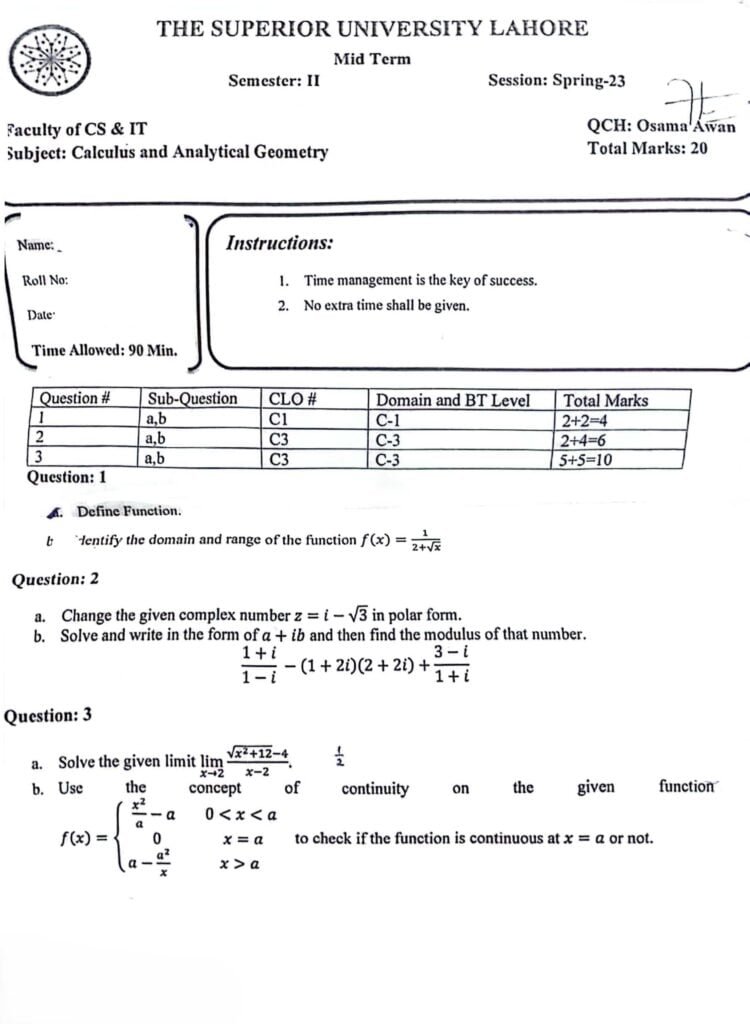Calculus and Analytical Geometry | Mid Term Past Paper | Superior University | VU Exam Guide

Table of Contents
Introduction to Calculus and Analytical Geometry
Superior University offers a foundational course called Calculus and Analytical Geometry that bridges the gap between algebra, geometry, and advanced mathematics. Students take this course to gain an introduction to the mathematical principles and techniques necessary for comprehending motion, changes, and system behavior. Anyone who wants to pursue careers in engineering, physics, computer science, or economics must master this subject.
What You Will Learn
By the end of this course, students will:
- Understand the basic principles of differential and integral calculus.
- Apply calculus to solve real-world problems.
- Analyze the geometry of curves and surfaces in space.
- Utilize mathematical models to represent physical phenomena.
- Develop problem-solving and critical-thinking skills.
Importance of Calculus and Analytical Geometry
It is impossible to exaggerate the significance of calculus and analytical geometry. It serves as the foundation for numerous technical and scientific fields. Analytical geometry gives us the means to perceive and solve geometrical issues, whereas calculus helps us to comprehend and characterize the behavior of evolving systems.
Real-Time Applications
Calculus and Analytical Geometry are utilized in various applications:
- Physics: Describing the motion of objects, understanding electromagnetism, and analyzing fluid dynamics.
- Engineering: Designing structures, analyzing stress and strain, and optimizing systems.
- Computer Science: Developing algorithms, graphics, and machine learning models.
- Economics: Modeling growth, optimizing production, and understanding economic change.
Historical Context
Both Gottfried Wilhelm Leibniz and Sir Isaac Newton worked independently to create calculus in the late 17th century. René Descartes and Pierre de Fermat were the pioneers of analytical geometry in the early 17th century. With the ability to depict the natural world with previously unheard-of precision, these mathematical advancements transformed the fields of science and engineering.
Job Opportunities
A solid foundation in Calculus and Analytical Geometry opens doors to numerous careers:
- Engineering: Civil, mechanical, electrical, and aerospace engineering.
- Data Science: Statistical analysis, machine learning, and artificial intelligence.
- Economics and Finance: Quantitative analysis, risk management, and actuarial science.
- Academia and Research: Teaching, academic research, and scientific development.
Salary Expectations
Salaries for professionals skilled in Calculus and Analytical Geometry vary based on the field and experience level. On average:
- Entry-level positions: $50,000 – $70,000 per year.
- Mid-level positions: $70,000 – $100,000 per year.
Achievements on a Big Level
Upon completing this course, students will:
- Gain a competitive edge in STEM fields.
- Be equipped to tackle complex problems in various industries.
- Have the potential to contribute to significant technological and scientific advancements.
Benefits of This Subject
Enhanced problem-solving skills: Calculus and Analytical Geometry hone analytical thinking and problem-solving abilities.
Foundation for advanced studies: This subject is essential for advanced mathematics and engineering courses.
Versatility: The concepts are applicable in numerous fields, making the knowledge highly valuable.
Current Market Value and Future Prospects
Calculus and analytical geometry continue to have a high market value, and there is a constant need for qualified workers in data science, engineering, and technology. With advancements in AI, automation, and cutting-edge research driving these sectors’ evolution and expansion, the future appears bright.
Project Ideas
- Modeling Population Growth: Use differential equations to model and predict population changes.
- Optimization in Engineering: Develop algorithms to optimize design and efficiency in engineering projects.
- Analyzing Financial Markets: Apply calculus to model and analyze market trends and economic indicators.
FAQs
- What are the prerequisites for this course?
- Basic understanding of algebra and trigonometry.
- How difficult is Calculus and Analytical Geometry?
- Challenging but manageable with consistent practice and study.
- Can I apply this knowledge in non-STEM fields?
- Yes, the problem-solving skills are highly transferable.
Interview Questions
- Explain the Fundamental Theorem of Calculus.
- How do you find the derivative of a function?
- Describe an application of Analytical Geometry in engineering.
Importance for Exams
Success on the exam depends on your ability to comprehend the fundamental ideas and how they apply. Exams frequently involve problem-solving questions, real-world applications, and theoretical understanding, according to past papers.

Note: You can also checkout all Subject’s Mid Term Past Papers of Superior University.
Conclusion
At Superior University, studying Calculus and Analytical Geometry not only sets you up for success in the classroom, but it also gives you the tools you need to have a successful career in a variety of fields. Accept this topic to open up a world of progress and opportunity.
 Virtual University
Virtual University
 Superior university
Superior university